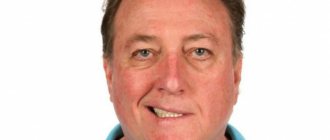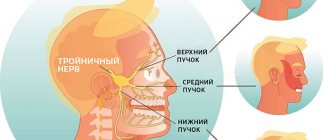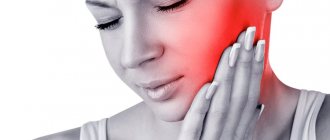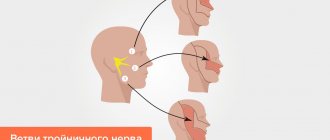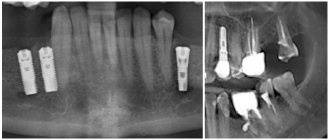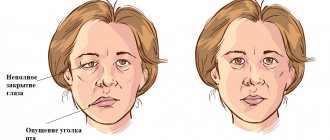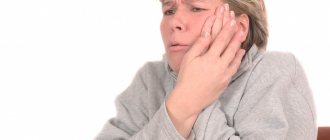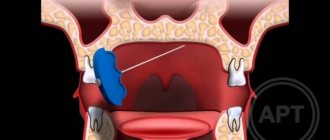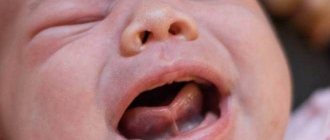Facial neuritis - symptoms and treatment
Neuritis (neuropathy) is a disease of the nervous system, manifested in dysfunction of a nerve or a certain group of nerves.
In recent years, the Greek word “pathos”, which means “suffering”, has been used to denote syndromes of damage to the peripheral nervous system, and previously used terms, for example, “neuritis”, have been replaced by “neuropathy”, “sciatica” by “radiculopathy”, etc. d. If several nerves are inflamed, then it is polyneuropathy, if one nerve is inflamed, then it is mononeuritis. When the cause of inflammation of the nerves is, for example, diabetes, we talk about diabetic polyneuropathy, [1] and if there is an infection, then about infectious polyneuropathy (for example, herpes, diphtheria, etc.); [2] if the factor is hereditary, then it is hereditary polyneuropathy; if associated with a nutritional disorder, for example, alcohol abuse, then alcoholic polyneuropathy; if polyneuropathy appears against the background of reduced immunity, then it is idiopathic polyneuropathy, etc. [3]
Many types of peripheral neuropathy are often caused by exposure to toxic chemicals, malnutrition, injury and nerve compression, and also occur as a result of certain medications, such as those used to treat cancer and HIV/AIDS. [4]
As an example, consider such a common type of neuritis as neuritis of the facial nerve, also called Bell's palsy, the incidence of which is 23 people per 100 thousand, in all age groups, regardless of gender. The average age of patients is 40 years.
Most often, facial paralysis occurs as a result of local hypothermia. The source of infection is often chronic processes in the mouth, throat, and ear. In acute otitis media, nerve damage is caused by perineural edema of vascular origin. But more often, facial paralysis is caused by the herpes zoster virus in the area of the external auditory canal and eardrum. [5]
Facial neuritis develops as a result of:
- tumor processes in the cerebellopontine angle and posterior cranial fossa, temporal bone, parotid gland;
- traumatic brain injuries;
- acute, chronic otitis, mastoiditis;
- infections - syphilis, tuberculosis, Lyme disease, HIV infections, malaria, diphtheria, typhus, etc.;
- sarcoidosis, collagenosis, amyloidosis;
- Guillain–Barré syndrome;
- multiple sclerosis and many other diseases.
- Sometimes the development of neuropathy of the facial nerve is observed during pregnancy against the background of nephropathy.[6]
Lecture on the topic “Massage for neuritis of the facial nerve”
MASSAGE FOR FACIAL NERVE NEURitis
Facial neuritis
– acute damage to the facial nerve (VII pair), manifested by unilateral paralysis or paresis of the facial muscles. The disease deprives a person of the ability to control his face and show emotions: frown, smile, raise his eyebrows in surprise, and even chew food normally. The facial nerve innervates the facial muscles.
Causes of neuritis of the facial nerve
- Hypothermia. In the case of neuritis of the facial nerve, local hypothermia is especially dangerous. For example, you were in a draft for a long time.
- Hypertensive crisis. Hypertension can lead to increased intracranial pressure. In this case, the nuclei of the facial nerve are affected.
- Previous viral infectious disease, for example, acute respiratory viral infection.
- Chronic inflammatory processes of the ENT organs, for example, otitis media. Also, the occurrence of facial neuritis can be facilitated by operations performed for purulent lesions of these organs.
- Trauma (crack or fracture) to the jaw or base of the skull.
- Stress and depression. Such conditions undermine the health of the nervous system and the body's defenses as a whole.
Classification of the disease
The classification is based on a causal factor, as a result of which they distinguish:
- primary or catarrhal neuritis, which occurs against the background of complete well-being in people after exposure to the cold factor;
- secondary, developing as a complication of concomitant pathology, for example, herpetic infection, otitis media or mumps;
- due to the impact of a traumatic factor and damage to the facial nerve, changes in local blood circulation during strokes, as well as a tumor or infection that affects the nervous tissue.
Clinical picture of the disease
Neuritis of the facial nerve develops slowly. At first, only pain behind the ear may appear. After a few days, facial asymmetry appears and paralysis of the facial muscles on the affected side occurs. In this case, there is a smoothing of the nasolabial fold on the affected side, and drooping of the corner of the mouth. Also, the patient cannot close the eyelids on the same side, and when trying to do this, Bell’s symptom appears - the eyeball turns upward. The patient cannot bare his teeth, smile, raise his eyebrows, close his eyes, or make his lips appear like a tube. Speech is somewhat difficult.
Since the facial nerve has several bundles that provide sensitive innervation, the following symptoms may occur: loss of taste sensitivity in the anterior third of the tongue, salivation, dry eyes or, conversely, lacrimation. Some patients exhibit an interesting feature. Dry eyes cause tearing when you eat. A number of patients experience hyperacusis - ordinary sounds seem loud and too sharp to them (damage to the nearby auditory nerve).
Diagnosis of neuritis of the facial nerve
Most often, the neurologist does not experience difficulties in making a diagnosis due to the presence of a clear, characteristic clinical picture. However, to confirm the diagnosis, additional examination methods are used - computed tomography or magnetic resonance imaging. They are mainly used to exclude concomitant diseases that could cause neuritis. Thus, a differential diagnosis must be made with a tumor or other inflammatory process (local or generalized).
During a neurological examination, the patient is asked to: close his eyes, raise his eyebrows, smile or bare his teeth, and also pretend to blow out a candle. With all these tests, facial asymmetry and the inability to fully perform these actions are observed. Sensitivity in the anterior third of the tongue is also examined by tingling this area. Observe whether there is tearing or dryness of the eye, which helps determine the level of nerve damage.
Therapeutic massage for neuritis of the facial nerve
The massage technique is strictly differentiated in accordance with the clinical characteristics and phase of the process.
Objectives of massage:
- improve blood circulation in the face area, especially on the affected side, as well as the neck and entire collar area;
- restore impaired function of facial muscles;
- prevent the occurrence of contractures and concomitant movements, and if they exist, help reduce their manifestations;
- restore correct pronunciation.
Contraindications to massage:
neuritis due to a tumor requiring surgical intervention, neuritis with the presence of an acute purulent process in the middle ear (massage is prescribed only after sanitation and elimination of the inflammatory process).
In the first week, massage of the affected side is not allowed. During this period, positional treatment, massage of the healthy half of the face and collar area, therapeutic exercises are carried out, and a week later massage is added on the affected side. During the first procedure, they teach how to relax the facial muscles and give advice on positional treatment in order to reduce asymmetry and restore normal ratios of the muscles of the affected and healthy side.
Treatment by position is as follows: sleep on your side (on the affected side); chew food on both the affected and healthy sides; sit for 10-15 minutes 3-4 times a day with your head tilted towards the affected side, supporting it with the back of your hand and leaning your elbow on the table; put a scarf on your head, tie it, pulling the muscles from the healthy side towards the affected side (from bottom to top), while trying to restore the symmetry of the face.
Massage area:
neck, collar area and face. They start with a massage of the collar area and neck, followed by a facial massage.
Massage techniques:
stroking, rubbing, kneading (very light), vibration - using a very gentle method.
Face massage
Teaching the patient to relax; at rest, it is necessary to relax the muscles of the healthy half of the face and for better relaxation, massage it, barely touching it, using continuous vibration with the palmar surface of three fingers very carefully, successively covering the forehead, cheek, and chin.
Direction of movement:
- from the middle of the forehead to the parotid region;
- from the base of the nose and the upper half of the cheeks to the corner of the lower jaw;
- from the wings of the nose and the lower part of the cheek to the submandibular lymph nodes.
These movements are repeated 1-2 times on the healthy side, and then simultaneously on the affected side (very carefully). On the affected side they begin to be used after seven days. At the same time, they try to achieve muscle relaxation and reduce asymmetry at rest.
Forehead massage
Massage techniques: light rubbing with spiral movements that does not cause redness of the skin, kneading (performed with the thumb and forefinger to create folds of the skin when raising the eyebrows), intermittent vibration such as puncturing (performed with the palmar surface of the second and third fingers alternately, lightly, but at a fast pace) . All these techniques alternate with stroking. Massage the frontal and temporal muscles.
Direction of movement:
- from the middle of the forehead to the temples (spiral stroking)
- from the brow ridges to the scalp.
The massage is performed on the affected side using a kneading technique, moving the fingers up, and on the healthy side, applying pressure with the fingers moving down. When kneading, your fingers should be above the eyebrows, without touching their scalp. After finishing the treatment, it is necessary to ensure that the patient does not wrinkle his forehead on the healthy side.
Massage of the eye sockets
Massage of the eye socket area is carried out with the eyes closed. The patient is asked to look down and then close his eyes. The massage therapist helps lower the eyelid on the affected side and very easily holds the eyelid closed with his finger (without touching the eyelashes) for 30 seconds.
After this, the massage therapist quickly gives the command to open and close your eyes 3 times in a row. The technique is repeated 2 times, then, with the eyes closed, the orbicularis oculi muscle is stroked with the palmar surface of the terminal phalanx of the middle finger, the direction of movement is from the temporal fossa, above the zygomatic arch to the inner corner of the eye, then along the upper edge of the orbit with two fingers to the temporal regions, sliding the index finger under , and the middle one above the eyebrow. This movement is repeated 3-4 times very carefully and gently, without moving the skin. After this, the patient is asked to squint (as when looking at the sun), and the massage therapist uses his index finger to lightly press under the eyelid and moves the finger to the nose.
Cheek massage
Massage techniques: superficial stroking, deep rubbing and kneading, vibration. Stroking is performed with the palmar surface of the last four fingers covering the nose (the thumb is under the chin).
Direction of movements: from the nose up to the zygomatic arch, to the ears, temples and corner of the mouth.
Rubbing is carried out in the direction from the lower jaw to the nose with the back of the terminal and middle phalanges of the four fingers. Vibration is carried out by the palmar surfaces of the fingers or the back surfaces of the middle phalanges of the fingers. It is very important to influence the nasolabial fold, lips, and corner of the mouth. The patient is asked to puff out his cheeks, followed by relaxation. Lower your head down, inhale and at the moment of exhalation say whoa, snort and vibrate your lips. Each exercise is repeated 3-4 times. The nasolabial fold is massaged from the corner of the mouth to the root of the nose, continuing the movement to its tip, stroking and rubbing with 3 and 4 fingers.
Nose massage
The nose is massaged from tip to bridge using the same techniques. Kneading is carried out by lightly pressing on the wings of the nose with the index finger (or thumb and forefinger) and at the same time the patient is asked to widen the nostrils. In cases where the patient cannot do this, the massage therapist only presses on the wings of the nose without the help of the patient. Often during the first procedures. The patient does not spread the wings of the nose, but wrinkles his nose. The impact on the cheek area is completed by performing an exercise in which the patient transfers air from one half of the mouth to the other, alternately on both sides (with lips closed).
When the nasolabial fold is smoothed, the following stroking technique is used: the thumb and index fingers should be placed along the fold at a distance of 2.5 cm from each other, and the fingers should be connected when moving.
Chin massage
performed by stroking, rubbing, kneading in the direction from the submandibular region to the chin fossa and the corners of the mouth with the palmar surfaces of four fingers. The technique is repeated 3-4 times on one side and the other.
Ear area massage
performed with the index and thumb, covering the ear in front and behind. The direction of movement is from the lobe upward, massaging the entire ear in turn. First, massage the front surface of the ear with the index finger, and then massage the back surface of the ear with the thumb. Kneading is carried out by squeezing the ear in the same sequence. The facial nerve is massaged 1 cm below the ear canal at the mastoid process using short-term point vibration. Impact on the nerve is permissible when the severity of the process subsides, when movements appear and their volume increases. In the final part of the procedure, all areas of the face are stroked.
After the massage, the following exercises for facial muscles are recommended:
- raise your eyebrows up, wrinkle your eyebrows (squint);
- close your eyes (the sequence of performing this exercise is: look down, close your eyes, holding the eyelid with your fingers on the affected side, and keep it closed for a minute, open and close your eyes 3 times in a row);
- smile with your mouth closed, squint;
- lower your head down, inhale and, as you exhale, snort and vibrate your lips;
- whistle, widen nostrils;
- raise the upper lip, exposing the upper teeth, lower the lower lip, exposing the lower teeth;
- smile with your mouth open, put out a match;
- take water into your mouth, close your mouth and rinse, being careful not to throw out the water;
- puff out your cheeks, transfer air from one half of your mouth to the other alternately;
- lower the corners of your mouth down with your mouth closed, stick out your tongue and make it narrow;
- opening your mouth, push your tongue back and forth, move your tongue left and right;
- stick your lips out;
- follow with your eyes the finger moving in a circle;
- pull in your cheeks with your mouth closed;
- lower the upper lip onto the lower one;
- move the tip of your tongue along the gums alternately in both directions with your mouth closed.
Exercises to improve articulation:
- Pronounce the sounds o-i-u, p-f-v, placing your lip under the upper teeth.
- Pronounce a combination of these sounds, syllables: oh-fu-fi, etc.
- Pronounce words by syllables (o-kosh-ko, fek-la, i-zyum, pu-fik, var-fo-lo-mei, i-vol-ga).
It is recommended to perform exercises in front of a mirror. At the same time, before each exercise, you should definitely relax the muscles, especially on the healthy side. Exercises are always carried out simultaneously for the healthy and affected half of the face. Symmetrical movements should be achieved. On the affected side, exercises are performed passively with the hand, and when minimal active movements occur, they are performed actively with the hand. As movements are restored, the same exercises are performed with resistance. Each exercise is repeated 4-5 times in a row with pauses for rest. Procedures are carried out 2-3 times a day.
For residual effects of neuritis with pronounced contractures, stroking and rubbing techniques are used. Kneading and vibration are contraindicated. An effective treatment method is acupressure (see Appendix 4).
Information sources:
- Vasichkin V.I. Massage. Lessons from the great master - M.: AST; St. Petersburg, Polygon, 2011.
- Epifanov V. A. Therapeutic physical culture. - M.: GEOTAR-Media, 2009.
- Shtulman D. R., Levin O. S. Nervous diseases. - M.: Medicine, 2000.
How effective is massage in the treatment of facial neuritis?
Sessions are used to relieve physical and psychological stress and provide an opportunity to relax. With them, muscle function is restored, full facial expressions return. Massage for neuropathies improves local blood and lymph circulation and relaxes muscle tissue.
Procedures used:
- to increase tone;
- improving the condition of the dermis - due to the preservation of cell nutrition and trophism;
- normalization of the flow of biological fluids in the affected areas.
Important! The right approach to the problem helps to get noticeable results within a few hours after completing the session. Lasting changes require long-term manipulation.
| Before | After |
Massage techniques
Facial massages for neuritis of the facial nerve involve the use of several types of procedures with the parallel performance of a set of special exercises. Regardless of the therapy option, movements occur along massage lines. Tapping, effleurage and forceful techniques are strictly prohibited.
Segmental
The technique allows you to strengthen relaxed facial muscles, get rid of swelling and stagnation in the nerve canal, and improve conductivity and excitability of endings. The segmental direction consists of techniques:
- soft vibrating movements;
- light stroking - performed with fingertips;
- rubbing.
Important! The procedure is carried out easily, without additional pressure. In the absence of concomitant inflammation, the use of a vibrating massager is allowed.
Exercise therapy for illness
Spot
When the face is affected, the following areas are affected:
- area between the eyebrows - designed to suppress pain, reduce fatigue, increase concentration;
- the inner edge of the eyebrows is massaged to resolve nasal congestion, increase visual acuity, and relieve discomfort;
- upper corners of the lips - therapy relieves symptoms of stress;
- the back surface of the neck in the area of the spine - eliminates signs of inflammation of the nerves, fights cephalalgia, eye pain, migraines;
- 2 cm above the ears - relieves attacks of headaches, treats neuritis of the auricular nerve.
A simple but effective technique that can be used by the patient independently. It involves influencing individual biological active points related to the projection of systems and organs.
Self-massage
At home, massages for inflammation of the trigeminal nerve on the face are carried out using the classical method. These include:
- circular movements with pads and fingertips;
- slight tingling sensation.
Important! Treatment begins with treating the healthy part of the face. At the same time, special gymnastics is used. You can use a bioenergy massager with different attachments at home (with your doctor’s approval). The main goal of the procedures is to target problem areas.
Self-massage for illness
Duration of exposure
Standard course therapy includes from 20 to 25 procedures. The duration of the session is about 20 minutes, 5 are given for warming up, and 10 for the manipulation itself.
Therapy takes place in three stages according to plan:
- basic - the first 10 days, without affecting the affected area;
- main – 3 months, intended for recovery;
- final - up to 3 months, used to eliminate residual symptoms.
Important! Questions about the duration and specifics of the therapy technique are resolved by the attending physician.
Preparation and tasks of massage
Before starting a course of treatment, it is necessary to undergo an examination by a neurologist, an ENT specialist, an ophthalmologist, donate blood for a general analysis, and undergo an X-ray of the skull. The results of the examination make it possible to exclude a tumor, otitis media and other diseases with damage to the facial nerve, in which massage is ineffective.
A massage therapy course solves the following problems:
– improves blood circulation in the face, neck and collar area;
– restores the function of facial expressions and speech;
– prevents contractures, if present – reduces manifestations.
Exercises for the main period of therapy
Classes during the main period, which lasts up to 3 months, are aimed at restoring the facial activity of muscle tissue. At this time, it is important to involve the entire peripheral muscle system in training in order to achieve the desired effect.
The duration of position therapy at this time is increased to 6 hours per day. It is alternated with acupressure facial massage and exercise therapy.
During this period, physical therapy is the most important component of treatment. It is better to perform exercises in front of a mirror to observe facial changes. The first classes must be conducted under the guidance of an experienced exercise therapy instructor.
Note!
During training, control the symmetry of the movements performed! To achieve this, muscle movement on the part of the face undamaged by the disease is limited with the hand.
Let's consider examples of performing exercise therapy for neuritis of the facial nerve at this time:
- Move your eyebrows up and down;
- Close your eyes, shifting your gaze with closed eyelids, which you need to hold with your hand;
- Smile without opening your mouth;
- Squint;
- Exhale air, vibrating your lips (snorting);
- Flare nostrils;
- Lift one and then the other lip successively so that the gum is visible;
- To frown;
- Smile with your mouth wide open;
- Light a match and blow out its flame;
- “Rinse” water in your mouth with your mouth closed, trying to “retain” all the liquid without spilling it;
- Whistle;
- Take air into your cheeks and release it;
- Take air into your cheeks and “drive” it from one cheek to the other;
- Lower the corners of your lips;
- Stick out your tongue and try to roll it into a tube;
- Show tongue;
- Stick out your tongue, moving it left and right;
- Close your mouth, fold your lips like a duck, stretching them forward;
- Moving your finger in a circle, carefully follow it with your eyes;
- Close your mouth and pull your cheeks in as much as possible;
- Try to cover your lower lip with your upper lip;
- Close your mouth and run your tongue along the gums from above and below.
Gymnastics are also performed to improve articulation abilities:
- Draw out the sounds o, i, u;
- “Cover” the upper row of teeth with your lower lip and pronounce p, f, v;
- Say oh, pu, vo, fu, ko, fi;
Pronounce syllable by syllable words that contain the following syllables: i-vol-ga, o-kosh-ko, etc. Once nerve conduction has been restored, resistance exercises can be used. The hand acts as a resistance tool. It “prevents” you from performing the necessary movements, thereby increasing muscle tension.
All exercises can be used 5 times each, taking short breaks to rest between them.
If the functionality of facial expressions cannot be fully restored, the exercises are distributed in such a way as to limit the moving part of the face. This technique will help “mask” the defect.
